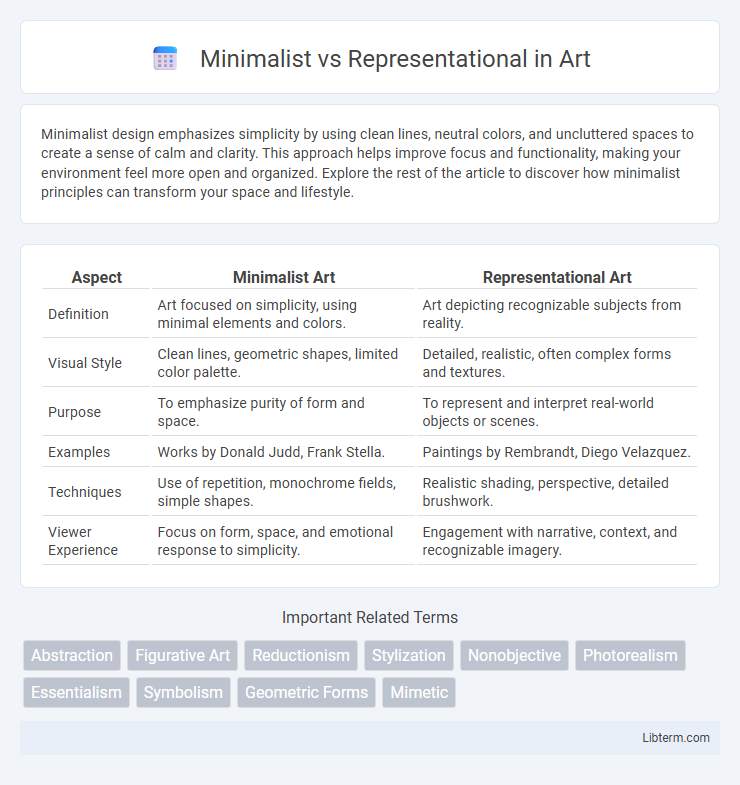Minimalist design emphasizes simplicity by using clean lines, neutral colors, and uncluttered spaces to create a sense of calm and clarity. This approach helps improve focus and functionality, making your environment feel more open and organized. Explore the rest of the article to discover how minimalist principles can transform your space and lifestyle.
Table of Comparison
| Aspect | Minimalist Art | Representational Art |
|---|---|---|
| Definition | Art focused on simplicity, using minimal elements and colors. | Art depicting recognizable subjects from reality. |
| Visual Style | Clean lines, geometric shapes, limited color palette. | Detailed, realistic, often complex forms and textures. |
| Purpose | To emphasize purity of form and space. | To represent and interpret real-world objects or scenes. |
| Examples | Works by Donald Judd, Frank Stella. | Paintings by Rembrandt, Diego Velazquez. |
| Techniques | Use of repetition, monochrome fields, simple shapes. | Realistic shading, perspective, detailed brushwork. |
| Viewer Experience | Focus on form, space, and emotional response to simplicity. | Engagement with narrative, context, and recognizable imagery. |
Introduction to Minimalist and Representational Art
Minimalist art emphasizes simplicity, using geometric shapes, clean lines, and limited color palettes to evoke clarity and focus. Representational art depicts recognizable subjects with realistic details, aiming to reflect the natural world or human experience. Both styles offer distinct approaches to visual expression, contrasting abstraction with concreteness.
Defining Minimalism in Art
Minimalism in art emphasizes simplicity by stripping away extraneous details to focus on fundamental geometric forms and monochromatic palettes, creating a sense of purity and clarity. This movement contrasts sharply with Representational art, which seeks to depict recognizable objects or scenes with detailed accuracy and narrative context. Minimalist artworks often use repetition and industrial materials to evoke an objective experience devoid of personal expression or symbolism.
Key Characteristics of Representational Art
Representational art emphasizes the accurate depiction of visual reality, capturing recognizable subjects with detailed forms, textures, and colors. Key characteristics include lifelike proportions, perspective, and clear narrative elements that convey stories or messages. This style contrasts with Minimalism's abstraction by prioritizing detailed representation and emotional engagement through familiar imagery.
Historical Evolution of Both Styles
Minimalist art emerged in the 1960s as a reaction against the emotional intensity of Abstract Expressionism, emphasizing simplicity, geometric forms, and monochromatic palettes to evoke pure visual experiences. Representational art, with roots stretching back to prehistoric cave paintings and flourishing through the Renaissance, focuses on depicting recognizable subjects and realistic details to convey narratives or emotional depth. The historical evolution of Minimalist and Representational styles highlights a shift from detailed figuration toward abstract reduction, reflecting broader changes in cultural values and artistic philosophies over time.
Notable Artists and Iconic Works
Minimalist art features notable artists such as Donald Judd, known for his geometric sculptures like "Untitled" (1969), and Agnes Martin, whose grid-based paintings exemplify simplicity. Representational art includes figures like Norman Rockwell, famous for his detailed storytelling in works like "Freedom from Want" (1943), and Edward Hopper, who captured American life in paintings such as "Nighthawks" (1942). These artists and their iconic works highlight the contrast between abstraction and detailed depiction in modern art movements.
Visual Impact: Simplicity vs. Detail
Minimalist art leverages simplicity through clean lines, limited color palettes, and large areas of negative space to create a powerful and immediate visual impact. Representational art relies on detailed imagery, intricate textures, and realistic elements to evoke emotional responses and convey complex narratives. The contrast between minimalist clarity and representational richness defines their distinct approaches to engaging viewers visually.
Emotional Expression and Audience Interpretation
Minimalist art uses simple forms and limited color palettes to evoke subtle emotional responses, encouraging viewers to find personal meaning through introspection and contemplation. Representational art employs recognizable imagery and detailed depictions to convey specific emotions and narratives, allowing audiences to connect through shared experiences and cultural references. Emotional expression in Minimalism is often abstract and understated, while Representational art offers explicit emotional cues, shaping distinct modes of audience interpretation.
Minimalist vs Representational in Modern Design
Minimalist design emphasizes simplicity, clean lines, and functionality by reducing elements to their essential forms, often using neutral colors and open spaces to create a calm environment. Representational design incorporates detailed imagery and recognizable forms, aiming to convey real-world objects or concepts through realistic or symbolic visuals. In modern design, minimalism promotes clarity and user focus, while representational approaches enhance storytelling and emotional connection through vivid representation.
Pros and Cons of Each Approach
Minimalist art emphasizes simplicity and purity of form, enhancing clarity and allowing viewers to interpret meanings with fewer distractions but may be seen as emotionally detached or overly abstract. Representational art offers detailed, recognizable subjects that create immediate emotional connections and storytelling opportunities but can sometimes limit imaginative interpretation and appear overly literal. Both approaches cater to different artistic intentions: Minimalism excels in conceptual depth and universal appeal, while Representational art excels in narrative richness and visual accessibility.
Choosing the Right Style for Your Creative Goals
Minimalist art emphasizes simplicity, using clean lines and limited color palettes to convey concepts clearly, making it ideal for projects that require clarity and modern aesthetics. Representational art focuses on realistic, detailed depictions, suitable for conveying complex narratives or emotional depth in creative works. Selecting between minimalist and representational styles depends on whether the goal is to evoke straightforward visual impact or to communicate intricate stories and emotions.
Minimalist Infographic

 libterm.com
libterm.com